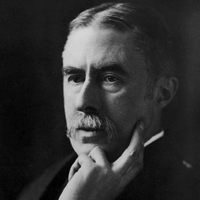Loveliest of Trees by Alfred Edward Housman: Summary
In the poem's opening lines; lines one and two, Housman describes the brilliant, natural beauty of a spring day. However, the use of the word "now" and its strong emphasis at the end of the first line confronts the reader with the short life of the cherries and the blooms.

Alfred Edward Housman
Use of the word "hung" in the second line describes not only a literal fullness, but also the heaviest of the boughs which we might feel cannot support the weight of the blooms forever. The word "hung" is also associated with death. Use of this image, then, could be seen as a metaphor for human mortality.
Lines 3-4: Here, Housman paints the reader a verbal picture or image of the many cherry trees in their white blooms. The third line creates a picture of the various cherry trees "standing" in the woodland "ride." The word "standing" works to create several associations; for example, the word is commonly used in the phrase a "stand" of trees, and it can also create the image of the trees as humans "standing." This giving of human qualities to the nonhuman is called personification. The word "ride” can, at the simplest level, imply a ride on horseback or carriage that the speaker of the poem might take through the woodland, but it can also refer to a "ride" of trees, meaning trees lying moored or anchored to the earth. The fourth line uses the word "Eastertide" to describe the cherry trees' white blossoms. Thus, while evoking associations of spring and the renewal of natural life, it brings, when viewed in conjunction with the word "now" in the first line, and "hung" in the second line, perhaps offers the reader more strongly the concept of the ephemeral, or briefness, of life before death ends it.
Lines 5-8: This section of the poem establishes that speaker of the poem is twenty years old, and that he believes his life span to be about seventy years, which leaves him only fifty more spring seasons. The strongly positioned "now" at the beginning of line 5 can be interpreted as working in parallel with the "now" at the end of line 1 to emphasize the sharp awareness of the briefness of this moment, the passing of time, and the shortness of human life. Line 6 expresses both the loss the speaker already feels of the twenty years behind him, and his keen awareness of being twenty only once in his lifetime-of having only this one spring while he is twenty. Note Housman's use of the word "score" at the end of line 7, how it echoes his use of the same word in line 5 in "threescore" and at the same time relates to the "score" of mathematics relating to the-remainder of his own life.
Lines 9-10: These lines clearly express and solidify the speaker's anxiety about what he feels is the briefness of his life. Even with the assumption that he has fifty years left, he anticipates how quickly the time will pass, with the inevitability of death coming too soon. Housman's choice of the phrase "little room" in line 10 suggests an image of a small, space in which he feels he exists, a sort of cramping of time around him, which could be seen as a metaphor for the absence he feels of a wide, open stretch of time ahead.
In the final lines of the poem, the speaker, because he has realized the shortness of life and the sureness of mortality, chooses to spend this moment, this time that he still has, to go to see the spring cherry trees in their full ripeness of heavy blossom. The trees are "hung with snow," which could be simply a lyrical way of describing the white blossoms, but also takes the reader back to line 4 where the trees are "wearing white" in the pureness of Eastertide. In line 12, the white snow might predict the chill associated not only with the inevitable winter to come, but the chill of death. Housman, in using images of the abundance of a fresh and pure Easter spring, the "hanging" of the blooms on their boughs, as well as the "hanging" of the boughs with snow, produces an irony and a tension which could make the reader feel the conjunction of aliveness and mortality the speaker feels in the poem.
Literary Spotlight
Introduction of Loveliest of Trees
Critical Analysis of Loveliest of Trees
Biography of Alfred Edward Housman
 |
bachelorandmaster.com |